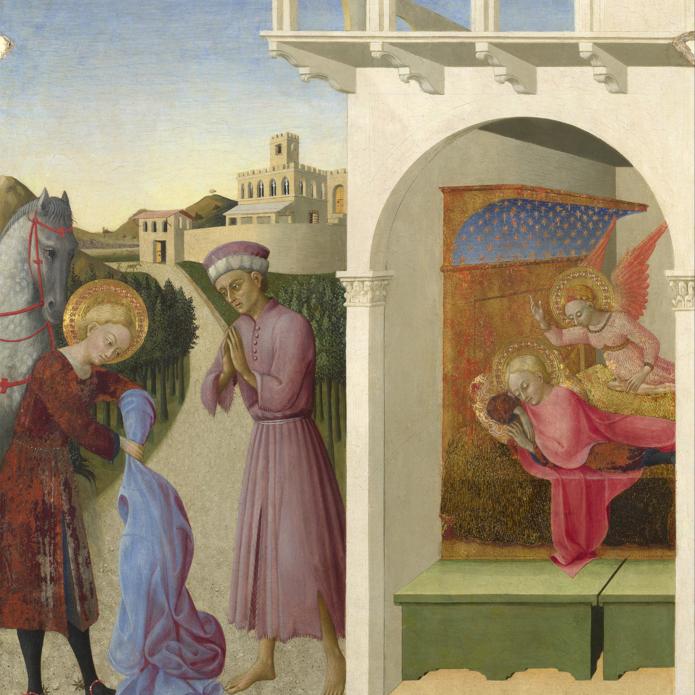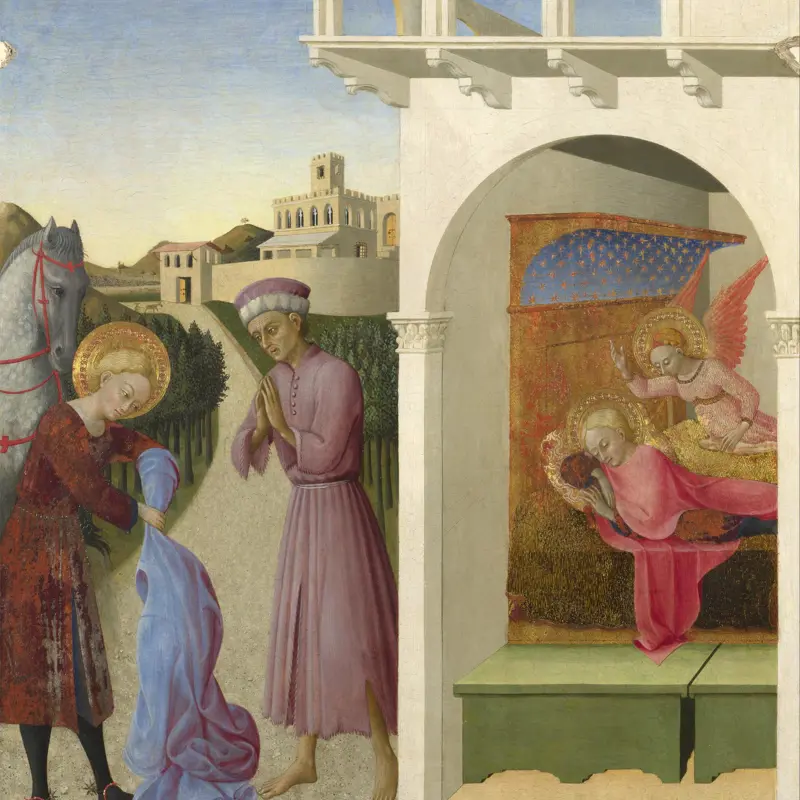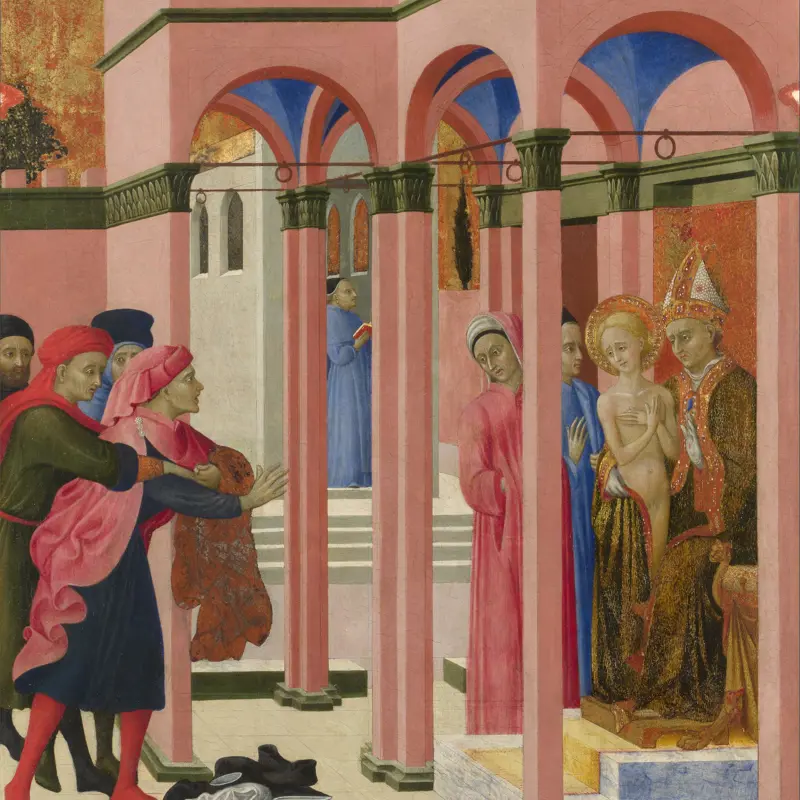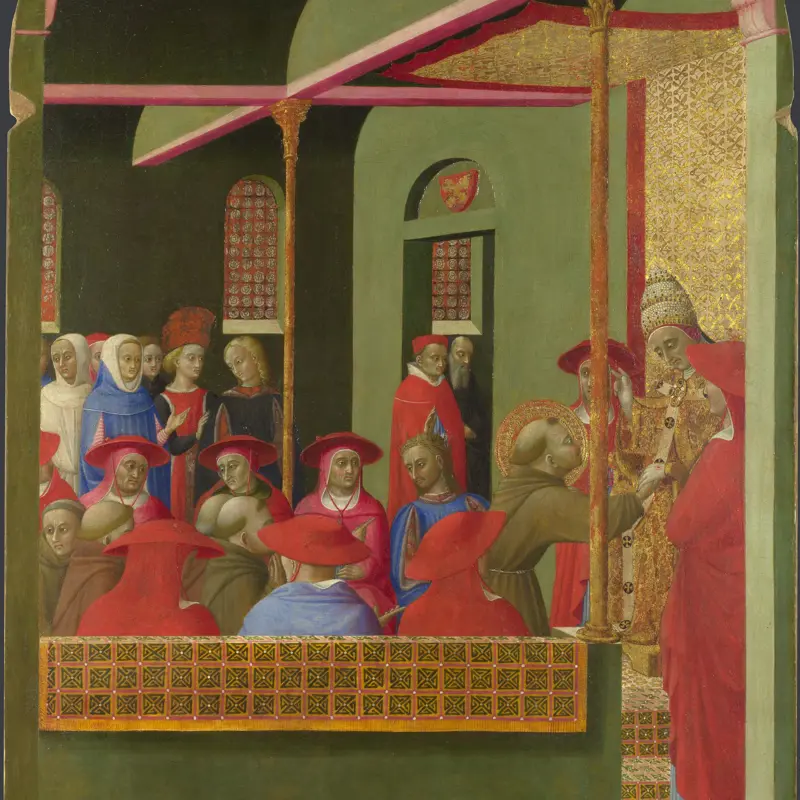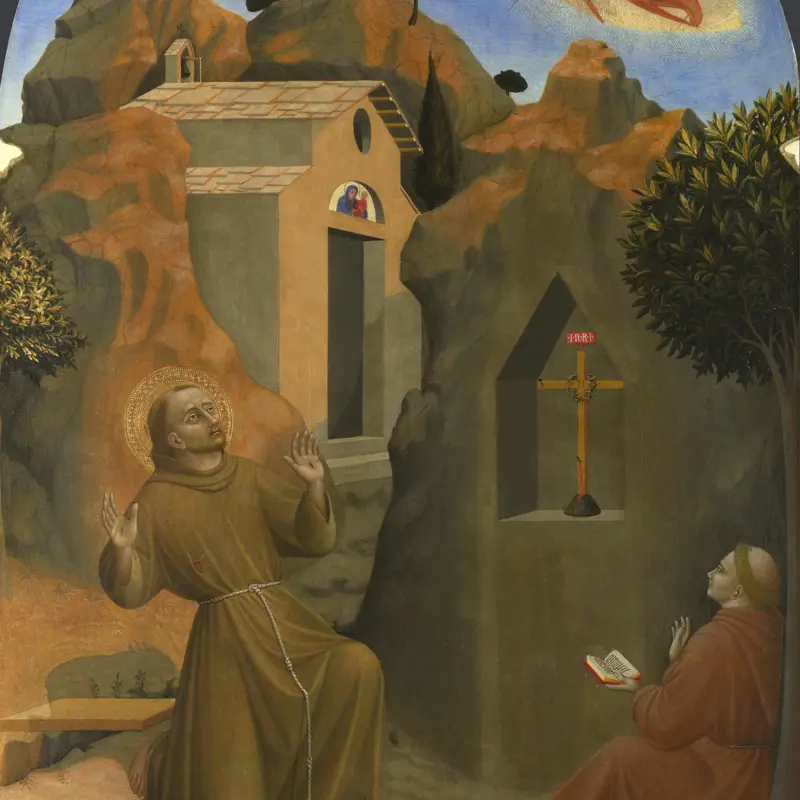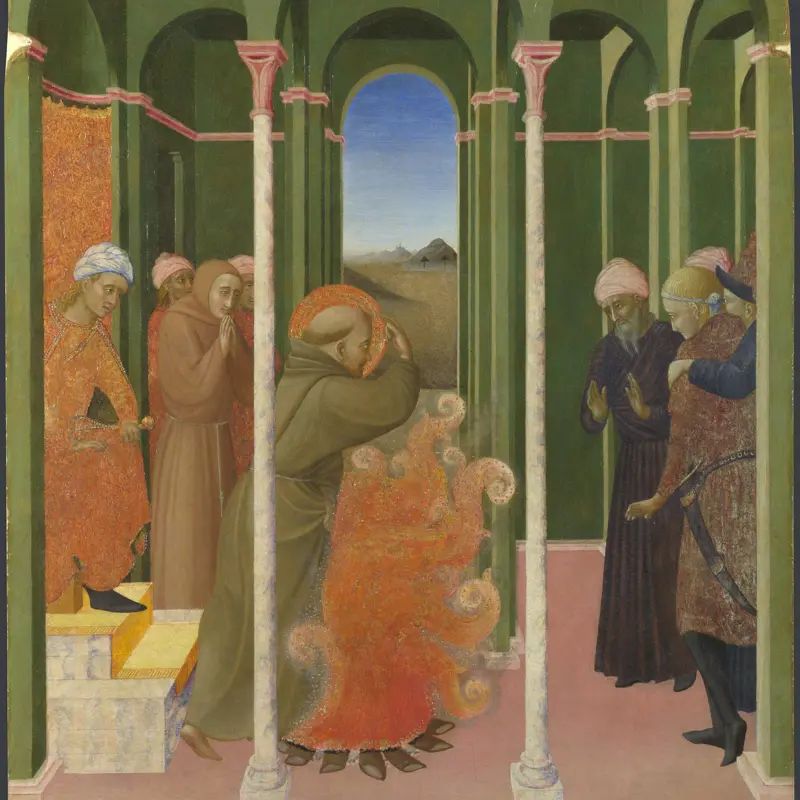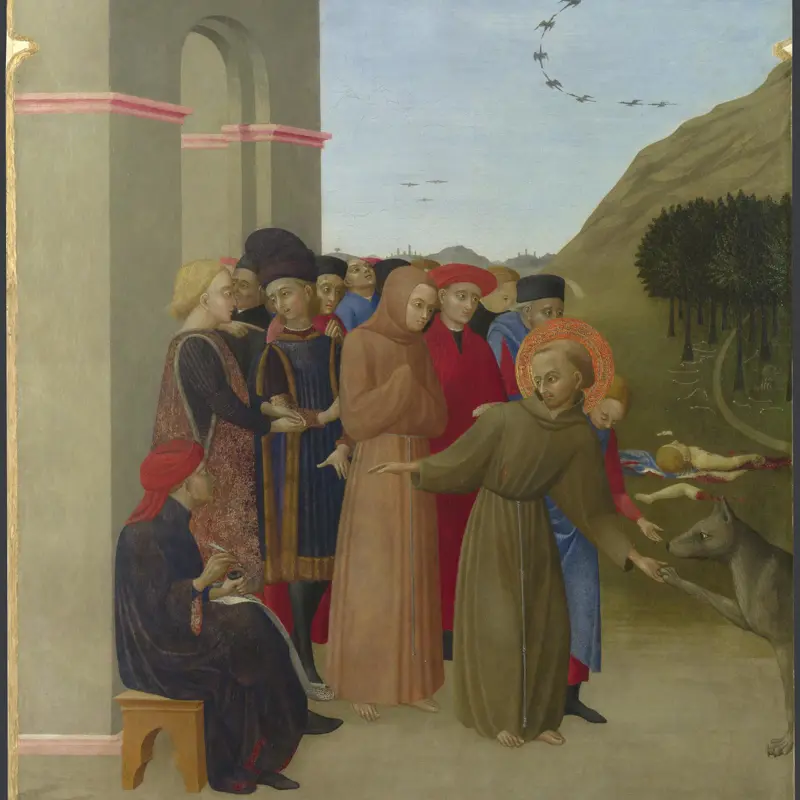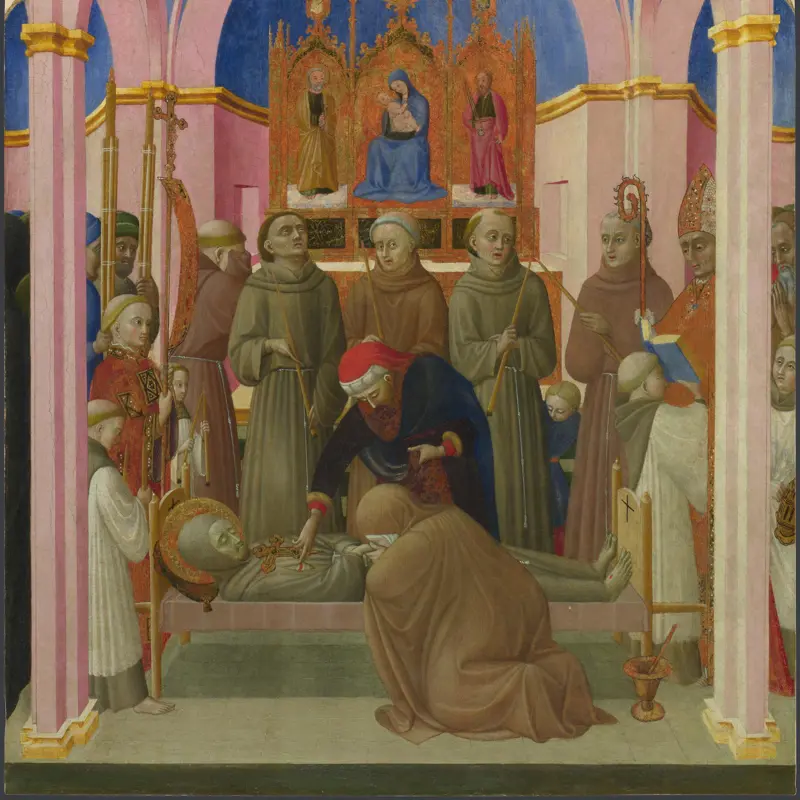Sassetta, 'Saint Francis before Pope Honorius III', 1437-44
About the work
Overview
In a vaulted green hall, Pope Honorious III blesses Saint Francis of Assisi, watched by assembled cardinals and various others. This is the third of a series of eight panels depicting episodes from Saint Francis’s life. They were part of a sumptuous double-sided altarpiece Sassetta made for the friars of Borgo San Sepolcro, which was completed in 1444. The back showed Saint Francis in Glory surrounded by these narrative scenes, seven of which are in the National Gallery’s collection.
According to the scripta, the written instructions setting out the subject matter for the altarpiece, this scene shows Pope Honorious III granting Francis the Indulgence of the Portiuncula in 1216. The friars at San Sepolcro may have requested this episode because they believed, wrongly, that Ranieri Rasini, a local holy man who was buried below the altar at San Sepolcro, was a witness to this event. The friar at the far left, turning to look over his shoulder, is possibly intended to represent Ranieri.
Key facts
Details
- Full title
- Saint Francis before the Pope: The Granting of the Indulgence of the Portiuncula
- Artist
- Sassetta
- Artist dates
- Active by 1427, died 1450
- Part of the series
- San Sepolcro Altarpiece
- Date made
- 1437-44
- Medium and support
- Egg tempera on wood (poplar, identified)
- Dimensions
- 88.4 × 52 cm
- Acquisition credit
- Bought with contributions from the Art Fund, Benjamin Guinness and Lord Bearsted, 1934
- Inventory number
- NG4759
- Location
- Room 58
- Collection
- Main Collection
- Frame
- Replica Frame
Provenance
Additional information
Text extracted from the ‘Provenance’ section of the catalogue entry in Dillian Gordon, ‘National Gallery Catalogues: The Fifteenth Century Italian Paintings’, vol. 1, London 2003; for further information, see the full catalogue entry.
Exhibition history
-
2023Saint Francis of AssisiThe National Gallery (London)6 May 2023 - 30 July 2023
Bibliography
-
1935National Gallery, National Gallery and Tate Gallery Directors' Reports, 1934, London 1935
-
1951Davies, Martin, National Gallery Catalogues: The Earlier Italian Schools, London 1951
-
1986Davies, Martin, National Gallery Catalogues: The Earlier Italian Schools, revised edn, London 1986
-
2001
C. Baker and T. Henry, The National Gallery: Complete Illustrated Catalogue, London 2001
-
2003Gordon, Dillian, National Gallery Catalogues: The Fifteenth Century Italian Paintings, 1, London 2003
Frame
This tabernacle frame was made at the National Gallery, for the Saint Francis of Assisi exhibition in 2023. It draws inspiration from the frame on Sassetta’s Pala della Madonna della neve (Galleria degli Uffizi, Florence). Meticulously crafted from poplar wood, it is water-gilt with decorative motifs adorning the pilasters and the predella. Within the gilded Romanesque arched frames, incised trefoils in the spandrels are painted in a blue hue. Doric capitals adorn the frames and, along with the pilasters, are embellished with undulating foliage engraved into the gesso. The predella features sgraffito ornamentation.
Saint Francis before Pope Honorius III, one of eight panels from the high altarpiece of S. Francesco in Borgo Sansepolcro, Italy, originally formed a double-sided polyptych. Remarkably, all eight panels share a surviving frame, albeit in parts. In 1935 seven of the panels were detached from their original frames and entrusted to the firm G.P. Coulette, which crafted single frames.
About this record
If you know more about this work or have spotted an error, please contact us. Please note that exhibition histories are listed from 2009 onwards. Bibliographies may not be complete; more comprehensive information is available in the National Gallery Library.
Images
About the series: San Sepolcro Altarpiece
Overview
These paintings were once part of one of the largest and most splendid altarpieces of the early Italian Renaissance. Made up of almost 60 panels, the double-sided altarpiece was painted for the high altar of San Francesco in Borgo San Sepolcro, a town near Arezzo. The back, which was seen primarily by the friars, showed Saint Francis in glory surrounded by eight scenes of his life, seven of which are in the National Gallery’s collection.
Unusually, surviving documents tell us a lot about how it was commissioned, constructed and paid for. The project was begun in 1426 but had foundered, and in September 1437 Sassetta took over. In early 1439 two friars visited him in Siena, bringing the scripta, a document stating what he was to depict. Although they provided the text, the artist provided the imagination: the scripta states that the friars, themselves artisans, and the painter together should decide on the details.

